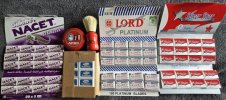- Messages
- 15,940
- Location
- Halifax, Republic of Yorkshire
The Rocca is bloody fantastic.
He's not wrong!
The Rocca is bloody fantastic.
I got out my other Star made razors, one branded with Personna on the top and the other Star.
The top of both
View attachment 119795
The underside of both
View attachment 119796
The one on the left is definitely zamak and has some wear to it. The one on the right looks near enough perfect. That could be down to less usage over the years but it seems to be a touch heavier.
I dunno, I've only seen zamak caps, and they look molded. (moulded for you fellas)Is this is US/UK difference?
See: https://www.theshavingroom.co.uk/community/threads/asr-double-edge-razor-weights.57595/ which details American caps as 2g lighter than British caps (9g versus 11g). In fact the later British caps were all heavier still at 13g.
I'm looking at the late PAL & Star caps that I have (the etched ones) and materially, it sounds like the brass baseplate when struck. My American caps make a different sound with less "sing". I do have an earlier Personna with a cap that is most definitely brass and that's even a tad heavier (at 15g).
What all that means, dunno?
Looking at them with a magnifier, my mint American cap shows no sign of any damage but the other is starting to look like yours. My British PAL and Star are well used but have no signs of decay.
Maybe the British ones have brass posts?
Mine doesn't and is zamak.Left side has buttresses while the right side does not. Might that indicate something about the materials?
Did the SE and DE come from the same factory?I particularly like the hex handles @TobyC given my love for the ASR flip-top single edge razors.
I have a very late 1912 which seems somehow thinner metal than practically all of my others and in line with some of the last models (Bathroom Set or Peerless) with round handles, this example has a think lightweight Personna DE handle with a protruding thread. I am pretty sure we've had a conversation around this before and the thought is that it's a home-made bodge ... but given how companies use up parts, I'm not so sure. I've also seen a Streamline (well, Ambassador Set) with a threaded thick heavyweight Personna handle.
Did the SE and DE come from the same factory?
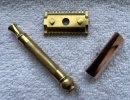
1930/31 Gillette Goodwill razor just arrived.
Good to see Davros and Sarah Jane Smith make an appearance.View attachment 119813
The wife treated me to a new T-shirt and some cracking shaving gear.
Woohoo she does love me after all ha ha.
1930/31 Gillette Goodwill razor just arrived.
The Gillette Goodwill is quite a scarce razor as it was only made for one year. The concept behind it was to introduce a new blade system using existing models and parts. It has quite a bit of the 1920's pocket edition look about it. This is the start of Gillette using razor blades as we see them today in that it has diamond shape in the blade that makes out part of the blade fitment/alignment characteristics. This was a move to oust the competition and restrict consumers to only their own products by means of offering a new blade with a patented design. This become an important part of Gillette's growth and domination of the industry. This very same campaign has had a huge impact on business as we know it, and has given rise to the 'Razor and blade business model' whereby you sell something cheaply (or even give it away) to 'trap' consumers into using your own products such as consumables that can only be supplied by a single company, thereby giving the seller the edge in pricing as there are no direct competition to push down prices.
The razor weighs 51 grams and stand 82 mm high. The base plate has perfect teeth but a small crack on the upper end of the barrel That somebody has soldered closed.
i liked the polished copper head cap, I thought maybe the coating had been removed but I have seen other Goodwills with the copper head cap. Whatever, I like it that way!
I used it for SOTD today 26/4
View attachment 119818
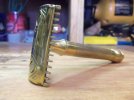
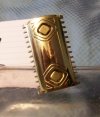
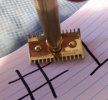
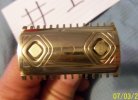
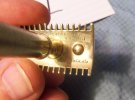

 www.badgerandblade.com
www.badgerandblade.com

Weird.I'm light on the detail here. I have heard that Ever-Ready had a factory in Scotland but no actual facts.
I showed this slip I found in the Star Embassy case which details The Hyde, London:

(Notice also the Star DE is written as a Micromatic)
